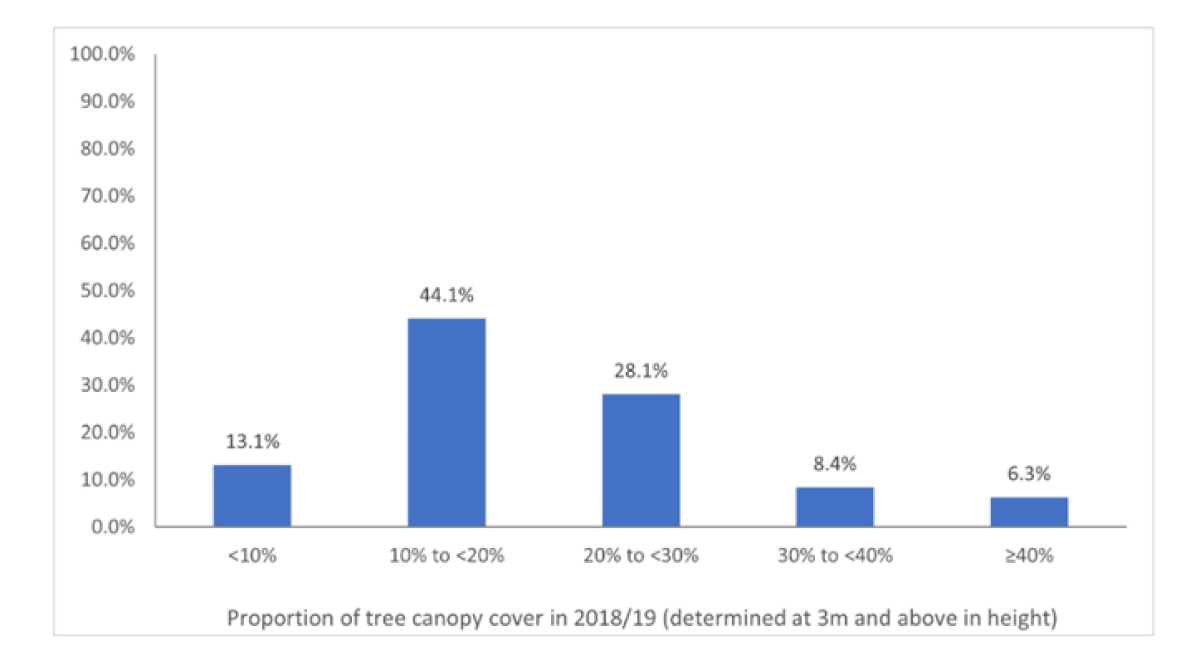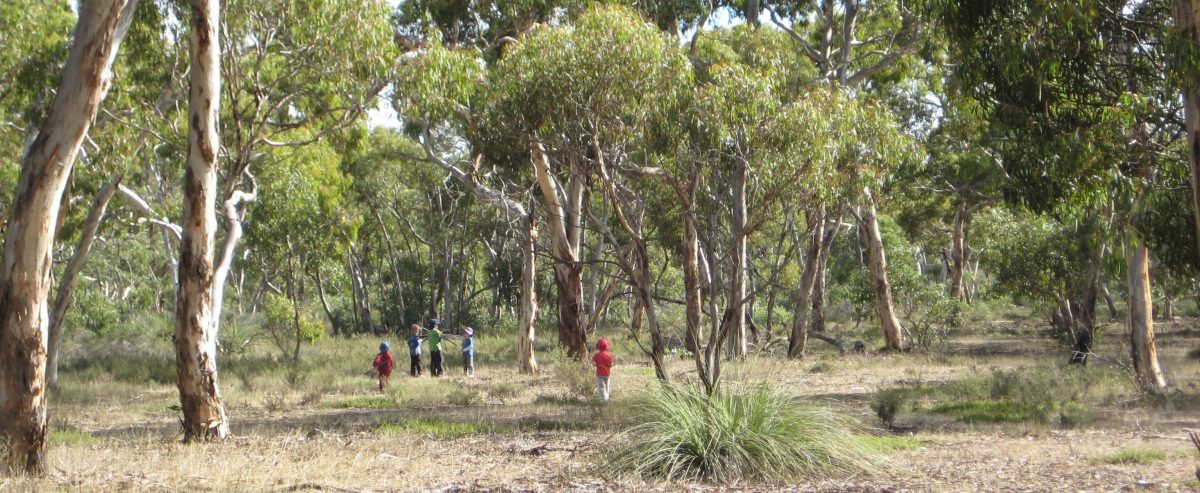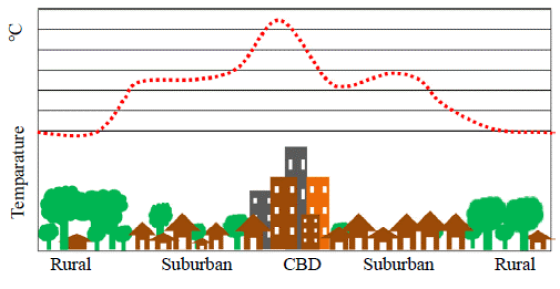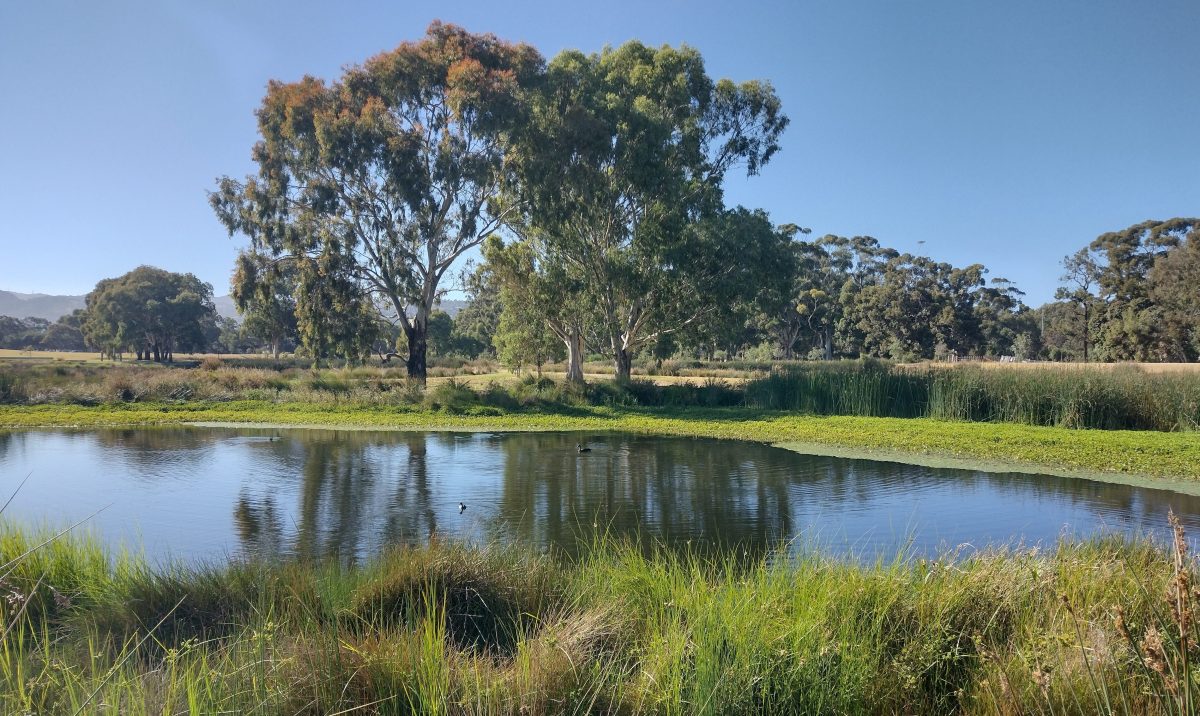- Home
- Environmental Themes
- Liveability
- Green Space
Green Space
Importance
Green space (both public and private), including tree canopies, has many benefits that support sustainable and liveable cities and healthy and connected communities, including:
- cooling cities by mitigating the ‘heat island effect’ and providing shade
- slowing stormwater runoff, mitigating flood risks and enabling recharge of groundwater
- filtering air pollution and improving air quality
- removing carbon from the atmosphere
- providing habitat for plants and animals, which protects biodiversity
- offering a space to be active, socialise, relax and connect.
Research undertaken in Sydney has also shown that combining green roofs with rooftop solar panels cools the surrounding ambient temperature, increases solar generation and boosts biodiversity.
Wellbeing SA has established a Wellbeing Index to monitor indicators of physical, mental, social/community and Aboriginal cultural wellbeing outcomes for South Australians over time. The index was launched in June 2022 and identifies determinants of wellbeing, which include ‘Urban Tree Canopy’ and ‘Access to public, open, green spaces’, recognising the importance of these urban characteristics to the health of the community. According to the Wellbeing Index:
- the proportion of metropolitan Adelaide suburbs in relation to the proportion of tree canopy cover in 2018–19 indicated that just under half of Adelaide’s suburbs had a tree canopy cover only of 10% to <20% over 3 m
- in 2021, 73.2% of South Australians surveyed in metropolitan Adelaide stated that they had access to green space within 400 m from where they lived.

Many respondents to the SOER YourSAy page mentioned that natural environments and green space were very important for the liveability of their area and for their health and wellbeing. Many also mentioned that they had concerns that urban sprawl and infill was reducing the area of green space and impacting the natural environment.

Green Space under Threat
The Australian Bureau of Statistics National Land Account indicated that, in 2016, South Australia had the lowest natural terrestrial vegetated wooded areas and the highest area of artificial surfaces within urban areas.
A study led by Nearmap indicates that, between 2011 and 2021:
- half of Adelaide’s suburbs lost at least 9.8% residential tree cover
- overall relative residential tree cover fell from 20.1% in 2011 to 18.3% in 2021
- specifically, there has been a loss of at least 10% residential tree cover in 131 out of 281, and a 10% increase in 18 out of 281, suburbs.
Evidence suggests that tree canopy cover in South Australia is under threat.
A report undertaken by the University of Adelaide in 2022 reviewed urban tree protection in Australia and determined that South Australia’s laws were markedly less stringent than those in New South Wales, Victoria and Western Australia. Tree protection laws for existing mature trees are currently being reviewed.
The Conservation Council of South Australia has provided detailed information on our declining tree canopies and provided 10 priorities for reform of tree protections in South Australia.
The World Wildlife Fund Tree Scorecard Report for 2023 states that, while South Australia is doing well in tree protection with 58% of forests and woodlands intact, no native forest logging and a range of conservation programs in place, South Australia still needs to address areas such as improving regulations, enforcement and data transparency.
Changes to land surfaces and the built environment or changing vegetation cover drive urban heat intensity trends and condition at a local scale. More trees and green space create cooler temperatures.

Many respondents to the SOER 2023 YourSAy page expressed concerns about reduction of green space in their community.

The overall urban heat in metropolitan Adelaide has remained stable between 2014 and 2023, with the average urban heat intensity in metropolitan Adelaide increasing by 0.20°C, indicating an overall stable trend. There is significant variation within local government areas, showing localised areas of warming and cooling between 2014 and 2023. Urban heat intensities for individual local government areas range from good (+1.8°C) to poor (+6.0°C).

Protecting Our Green Space
Pressures
- An increasing population requires somewhere to live resulting in urban sprawl and infill.
- Encroachment of urbanisation upon rural areas in a peri-urban environment.
- Limitations in protection measures to maintain sufficient green space and tree canopy cover.
Impacts
- Reduction in area of green space, tree canopies and vegetation.
- Reduction in permeable surfaces, increasing flood risks and impacts.
- Loss of environmental and human wellbeing benefits from a reduction in green space.
- Less spaces and transport corridors for native plants and animals leading to lower biodiversity.
- Increase in heat islands.
- Clearance of native vegetation, which impacts habitat for native species and biodiversity.
Responses
- One of the key objectives in the South Australian Government’s Climate Change Action Plan is to accelerate urban greening to reduce urban heat, create habitat for wildlife, and improve liveability and amenity. In response to this objective, DIT has established a Green Infrastructure Commitment to ‘identify and pursue feasible opportunities to expand green infrastructure (including WSUD) on public land, focusing on priority areas identified by Green Adelaide, corridors which provide for active travel, and new infrastructure projects’. It sets targets to increase urban green cover in South Australia by 20% by 2045 and provide shade trees to improve amenity for pedestrians, cyclists and public transport customers, targeting ≥50% canopy cover over footpaths and bikeways.
- A 30-Year Plan for Greater Adelaide target was to increase tree canopy cover to 30% for those council areas currently with less than this value and maintain tree cover for those areas with greater than 30% cover.
- The Green Adelaide Landscape SA Board is leading the creation of the first Urban Greening Strategy for metropolitan Adelaide, Australia’s first National Park City and a range of rewilding and biodiversity projects to address liveability in South Australia's major urban centre. A discussion paper has been produced by Green Adelaide that will inform the development of a strategy to support urban greening in metropolitan Adelaide.
- An Interim Report for the Inquiry into the Urban Forest was released in October 2023 and provides 13 recommendations to better protect tree canopies in urban areas.
- The State Planning Commission has progressed the 'Open Space and Trees Project' to enhance understanding of tree canopy coverage and policy responsiveness in the planning system. In 2022, the Commission published two reports to inform the Open Space and Trees Project. The findings are being considered, alongside the final report of the Planning System Implementation Review by an Expert Panel who have reviewed trees policy in relation to the Planning, Development and Infrastructure Act 2016, the Regulations, and the Planning and Design Code. The panel’s recommendations have recently been provided to the government and are under consideration.
- The Planning and Design Code includes ‘Performance Outcomes’ and ‘Deemed to Satisfy’ policy, which specifically direct the planting of trees in residential development. However, we are still seeing tree clearance or lack of planted trees in new developments.
- The Urban Tree Canopy – Local Government Leading the Greening of Adelaide provides an implementation plan and recommendations to maintain and enhance the urban tree canopy.
- The Urban Tree Canopy Off-set Scheme ensures that new development preserves and enhances the urban tree canopy through the planting of new trees and retention of existing mature trees.
- The Urban Heat and Tree Mapping Viewer provides high-resolution surface temperature data for the Adelaide metropolitan area to help plan activities to mitigate high temperatures and assess the effectiveness of urban infrastructure in mitigating heat islands.
- Healthy Parks Healthy People 2021–2026 was delivered by state government to facilitate the connection of people with nature to improve their health and wellbeing.
- Biodiversity sensitive urban design is being adopted or promoted in some areas to create urban areas that support native species and healthy ecosystems through the provision of habitat and food resources, for example, Green Adelaide and the Hills and Fleurieu Landscape Board.
Opportunities
- Research into how best to ‘rewild’ areas that have been cleared, including planting endemic species of plants.
- Incorporate and facilitate biodiversity sensitive urban design into planning.
- Encourage planting in backyards and gardens – Coastal Gardens A Planting Guide, Adelaide Garden Guide 2022.
- Implement a coordinated approach amongst agencies who are involved in enhancing and protecting green space.
- Review South Australia’s tree regulations to improve protection of trees and tree canopy in both existing and new developments.
- Expand the significant tree register to urban and peri-urban developments and townships.
- More research and specific action plans for effectively increasing tree canopy needs to be developed and supported by strategic policies.
- Improved stormwater management to increase and enhance green spaces, creating blue-green spaces and facilitating active watering of green space especially during summer.
- Selection of lighter-colour roofs to reduce the urban heat island effect in housing developments.

Further Reading
- Urban Heat and Tree Mapping Viewer – Provides high-resolution surface temperature data for the Adelaide metropolitan area.
- Biodiversity urban design – Supports human health and wellbeing and delivers ecosystem services.
- Urban Greening and Tree Canopy – Resources provided by the Local Government Association of South Australia for increasing tree canopy.
- Tree Scorecard 2023 – Report by World Wildlife Fund (WWF) on tree protection and restoration in Australia including snapshots for Australian states and territories.
- Healthy Parks Healthy People – Recognises the important link between a healthy natural environment and people’s health and wellbeing.
- Forests and Woodlands of the Adelaide Plains and Southern Adelaide Region in 1836 – A native planting guide that describes the type of vegetation and ecosystems as they probably were at the time of settlement. Interestingly, the River Torrens did not appear to flow directly into the marine environment during this time, rather it flowed into a reed bed and sedgelands.
